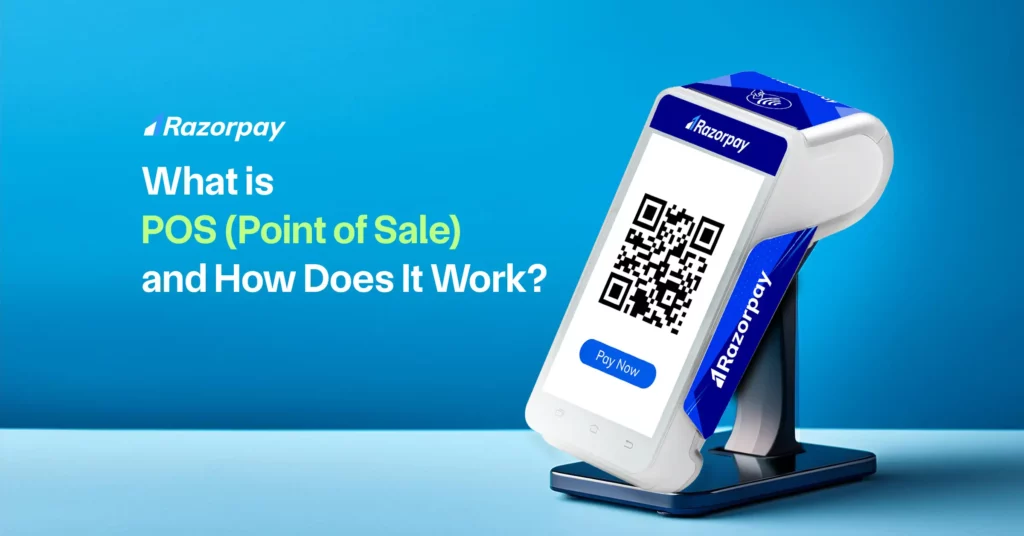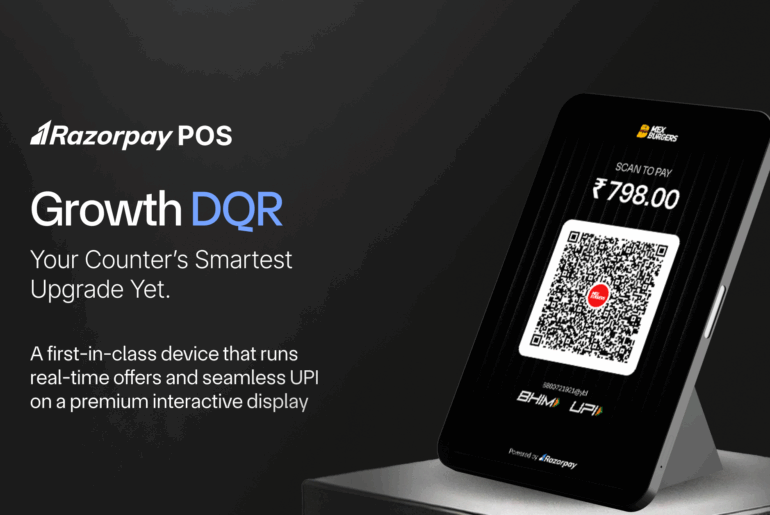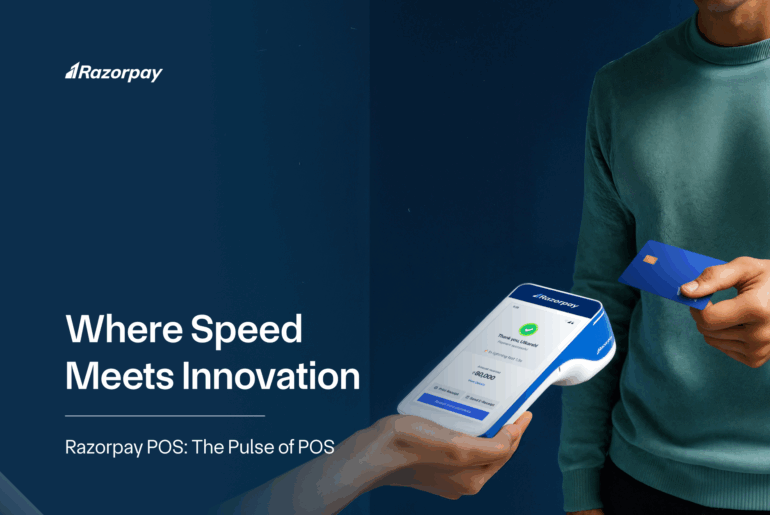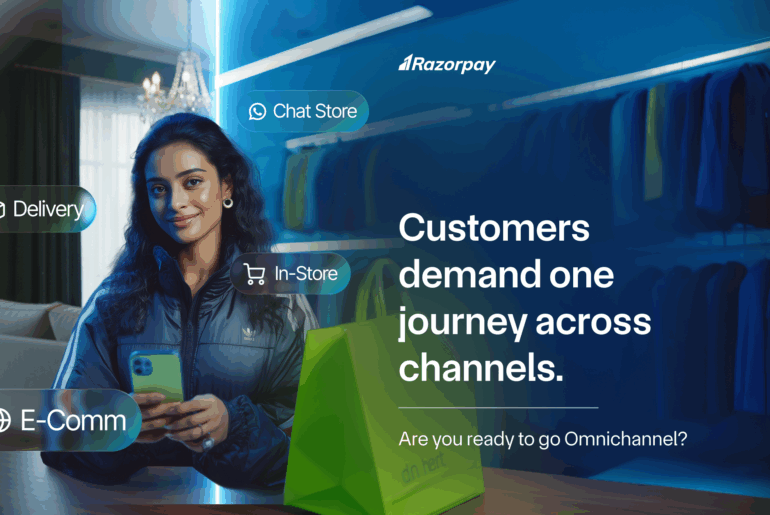Table of Contents
What Is POS (Point Of Sale) System?
A POS, or point of sale system, is a business payment machine that combines hardware and software to accept payments from customers and record sales data.
POS systems are the central hub for managing customer purchases, processing payments, and issuing receipts, and can be used in a variety of settings including physical stores, online stores, food trucks, and reception desks.
Some popular examples of POS machine systems in India include Razorpay POS and ePOS App.
Must Read: POS Machine Charges and Fees
Example of POS System
Decathlon and Razorpay POS: A Perfect Match
Decathlon, a global sports retailer, has successfully integrated Razorpay POS into its retail stores to streamline operations and enhance customer experience.

Here’s how the Decathlon Razorpay POS works:
- Customer Purchases: A customer selects sports equipment at a Decathlon store.
- Item Scanning: The cashier scans the items using the POS system, and the product details, including price and quantity, are displayed on the screen.
- Payment Processing: The customer chooses their preferred payment method. If they opt for digital payment, Razorpay POS provides seamless integration with various payment options like UPI, cards, and wallets.
- Order Summary: The POS generates a detailed order summary, including itemized list, total amount, and payment details.
- Inventory Management: The POS system automatically updates the store’s inventory, reflecting the sold items.
- Customer Data: With customer consent, Decathlon can collect customer data (like contact information, purchase history) to offer personalized recommendations and loyalty programs.
- Real-time Analytics: The POS system provides valuable insights into sales trends, product performance, and customer behavior, helping Decathlon make data-driven decisions.
Types of POS Systems
Here are the 10 different types of POS for your business
- Mobile POS system
- Web POS system
- Desktop POS system
- Handheld POS system
- Tablet POS system
- Terminal POS system
- Self service kiosk system
- Touchscreen POS system
- Multichannel POS system
- Omnichannel POS system
Related Read: Mini POS: Smart & Compact Payment Solutions
Specialized POS Solutions for Various Industries
Below is a discussion of a few popular industries using pos system for their businesses:
1. Retail POS System
It offer inventory management, customer relationship management (CRM), and sales analytics.
2. Hospitality POS System
It focus on table management, kitchen display integration, and menu customization.
3. Healthcare POS system
It prioritize patient information security, compliance with regulations, and integration with electronic health records (EHR).
How Does the POS System Work?
Here is the step-by-step process of how the POS system works
STEP 1: Transaction Initiation
-
The process usually begins when customers bring their selected items to the checkout counter.
-
The cashier or the user initiates the POS transaction on the POS system or machine by selecting “new transaction” or a similar option.
STEP 2: Item Scanning
-
Each product has a barcode that contains information about the item, such as its name, price, and other details.
-
The cashier scans the barcode using a barcode scanner connected to the POS system.
STEP 3: Product Information Retrieval
-
The POS system retrieves the POS data or information about the scanned product from its database.
-
This information may include the product name, price, quantity in stock, and any other details configured in the system.
STEP 4: Price Calculation
-
The POS system calculates the total purchase cost based on the scan and price.
-
It may apply discounts, promotions, or taxes as configured in the system to calculate an accurate final amount.
STEP 5: Payment Processing
-
After calculating the total amount due, the customer provides payment for their purchase.
-
The POS system supports various payment methods, including cash, credit/debit cards, UPI (unified payments interface), mobile wallets, and other electronic payments.
-
The cashier selects the appropriate payment method on the POS system and completes the transaction.
STEP 6: Receipt Generation
-
After successful payment, the POS system generates a receipt for the customer.
-
The receipt typically includes details such as purchased items with their prices, discounts applied, the total amount paid, and transaction details like date and time.
STEP 7: Inventory Update
-
While completing the transaction and generating a receipt, the POS system updates inventory records.
-
It deducts sold items from available stock in real-time.
-
Real-time inventory tracking helps businesses maintain accurate stock levels and avoid stockouts or overstock situations.
STEP 8: Sales Reporting
-
The POS system stores transaction data, allowing businesses to generate various reports.
-
Sales reports provide insights into best-selling products, peak sales hours, and overall business performance.
-
These reports help businesses make informed decisions about inventory management, marketing strategies, and sales forecasting.
STEP 9: Integration with Other Systems
-
Modern POS systems often integrate with other business tools, such as accounting software, customer relationship management (CRM) systems, and e-commerce platforms.
-
This integration ensures seamless data flow across different aspects of the business, enabling efficient management of sales and customer information.
STEP 10: Security Measures
-
POS systems incorporate security features to protect sensitive customer data and prevent fraudulent activities.
Benefits of POS Systems
A point of sale (POS) system offers numerous business advantages.
- It provides benefits such as accurate price track, efficient inventory management, detailed revenue analysis, and recognition of sales patterns.
- The POS payment integration can streamline retail operations through automated transactions and sales data tracking.
- Integrated technology in the POS systems can detect discrepancies, prevent profit loss, and improve customer service.
Related Read: What Is a Smart Terminal?
What Are the Hardware and Software Components of a POS?
A point of sale (POS) system comprises hardware and software components. The hardware includes a cash register, barcode scanner, receipt printer, and a card reader for accepting debit and credit card payments. On the other hand, the software component includes the POS application that manages sales transactions, inventory management, customer data, and reporting.
Common Hardware Components of POS
The hardware components of a POS system include:
1. Point of Sale Terminal
The central component of a POS system, it allows you to process transactions, manage inventory, and generate reports. The terminal typically consists of a touchscreen monitor, a cash drawer, and a card reader.
2. Barcode Scanner
Barcode scanners are widely used in industries, including retail, logistics, and healthcare. When a barcode is scanned, the scanner reads the pattern of black and white bars, converts it into a digital format, and sends the information to a connected computer or system for processing.
3. Cash Register
Commonly used in retail stores, restaurants, and other businesses, it records sales transactions and calculates the total amount due. The cashier enters the price of each item purchased, and the cash register calculates the subtotal, applies any discounts or taxes, and provides the total amount that the customer needs to pay.
4. Receipt Printer
To generate printed receipts for customers after completing a transaction, it connects to the POS system via cable or wirelessly, using thermal printing. The printer receives commands from the POS software, printing itemized lists, total amount, payment method, and applicable discounts.
5. Card Reader/Debit and Credit Card Terminal
These terminals allow customers to make payments using their debit or credit cards. They read the information stored on the card’s magnetic stripe or chip and authorize the transaction.
6. Customer Display
A customer display shows important information such as the total amount due, item details, and promotional messages to customers during checkout.
7. Cash Drawer
Used to securely store cash received from sales transactions, this drawer can be locked for added security and ensures the security and organization of cash during sales transactions. The cash drawer is connected to the POS terminal and can be opened only after a successful transaction, triggered by the POS software.
8. Receipt Paper
The receipt printer uses this paper to print the receipt for customers. It should be stocked and replaced when needed.
9. Signature Capture Pad (For Card Transactions)
It allows customers to sign electronically instead of signing physical receipts. The signature is thereafter stored digitally for future reference.
10. Kitchen/Bar Printer (For Hospitality)
In the hospitality industry, it is used to print the customer’s orders for the kitchen or bar. The printer receives orders from the POS system and prints them for the kitchen or bar staff.
Related Read: Difference between POS System and Cash Register
Common Software Components of POS
The software components of a POS system include:
1. POS Software
It is the core application that runs on the POS terminal. It provides features such as transaction processing, inventory management, and reporting. The software typically connects with hardware such as barcode scanners, receipt printers, and cash registers to streamline the in-store payment process and efficiently manage business operations.
2. Inventory Management Software
This software helps businesses track inventory levels, manage stock, and automate reordering processes. It integrates with various data sources, such as sales and purchase records to provide real-time updates on stock levels and streamline inventory control.
3. Payment Processing Software
It enables businesses to securely accept various payment methods. This software integrates with card readers or other payment gateways to facilitate transactions.
4. Reporting and Analytics Software
This software generates detailed reports on sales, inventory levels, and other key performance indicators. It collects data from various sources, organizes it, and processes it to generate detailed reports.
5. Customer Relationship Management (CRM) Software
The CRM software enables businesses to store customer information, track interactions, and manage relationships. It centralizes customer data, streamlines communication, and provides insights to enhance customer service and sales efforts.
6. Security Software
Security software protects sensitive data, such as payment information from unauthorized access. It includes encryption measures and firewalls to ensure data security.
7. Integration Software
It enables seamless integration between the POS system and other business tools, such as accounting software or e-commerce platforms.
8. Updates and Support Software
These are employed to provide users with access to a help desk or knowledge base where they can find solutions to common issues or assistance from support staff. It works by regularly checking for updates from the POS system’s developers or vendors. When updates are available, the software downloads and installs them automatically.
Read More: What is Payment Gateway and How does it Work?
Difference Between Cloud-based and On-premise POS Systems
Here’s the key difference between cloud based pos system and on premise pos system
Feature |
Cloud-Based POS |
On-Premise POS |
|
Hosting |
Hosted on remote servers |
Installed locally on-site |
|
Deployment |
Quick and easy deployment |
Requires hardware setup and installation |
|
Cost Structure |
Subscription-based, lower initial cost |
Higher upfront cost, lower ongoing fees |
|
Scalability |
Easily scalable, can add more terminals or locations |
Limited scalability, additional hardware required for expansion |
|
Maintenance |
Vendor handles maintenance and updates |
An in-house IT team required for maintenance |
|
Accessibility |
Can be accessed from anywhere with an internet |
Accessible only on-site or through VPN |
|
Internet Dependency |
Requires stable internet connection |
Not dependent on internet connectivity |
Related Read: POP vs POS Explained
How to Choose the Right POS System for Your Business?
The POS system must meet your business needs, fit your budget, and integrate with your existing tools. Ensure it is user-friendly, scalable, and offers security features, besides reliable customer support.
The below factors will help you choose the right POS system:
1. Understanding your Business Needs
Before selecting a POS system, you must identify and understand the unique requirements of your business. Consider factors such as the industry you operate in, the size of your business, and the volume of transactions that you handle.
2. Defining a Realistic Budget
Establishing a budget for your POS system is crucial, considering both upfront costs and ongoing expenses. Having a realistic budget will help you choose your options and make an informed decision.
3. Compatibility and Integration
Ensure your POS system seamlessly integrates with your existing hardware and other business tools, such as inventory management systems or accounting software. This will streamline your operations and improve efficiency.
4. Ease of Use and Training
Choose a user-friendly POS system that is intuitive and easy to navigate. This will minimize disruptions during staff training.
5. Scalability for Future Growth
Select a POS system that can scale with your business as it grows. Consider factors such as the number of users it can accommodate, support for multiple locations or outlets, and additional features that can be added as per your growing needs.
6. Mobile and Online Capabilities
If you have multiple locations or online sales channels, choose a POS system that offers mobile payment options like Razorpay POS or ePOS App integration.
7. Payment Processing Options
Consider flexibility in accepting various payment methods such as credit cards, mobile wallets, UPI, and net banking.
8. Security Features
Choose a POS system with robust security features like encryption, tokenisation, and payment card industry data security standard (PCI DSS) compliance.
9. Customer Support and Training
Reliable customer support is crucial to address any issues or queries that may arise during the implementation or usage of the POS system. Look for vendors that offer 24/7 support through various channels like phone, email, or live chat.
10. Trial Period or Demo
Take advantage of trial periods or demos offered by the POS system provider to test it in your business environment. This will help you assess its usability, compatibility, and suitability for your specific needs before making a final decision.
Related Read: What is an EPOS System: Types, Components and How Does it Work?
How Does Razorpay POS Help Your Business?
Razorpay POS is a comprehensive system that offers various benefits by empowering your business with efficient transaction management, enhanced mobility, and improved operational efficiency.
Benefits of using Razorpay POS
Using a payment solution like Razorpay POS, you can achieve greater business efficiency by reducing manual errors, eliminating the need for additional hardware or software, and enhancing customer experience with quick and hassle-free payments.
Related Read: POS vs ERP: Key Differences Explained
Frequently Asked Questions (FAQs)
1. Who needs POS?
A point-of-sale system is essential for any business that engages in in-person sales transactions.
2. What types of businesses can benefit from a POS system?
Various types of businesses like Grocery stores, Department stores, clothing stores, Electronics retailers, Pharmacies, Boutiques, Restaurants and Cafes, Food trucks, Hair salons, Fitness studios, Hotels and accommodations, etc…
3. Is a POS system suitable for small businesses?
Small businesses often stand to gain the most from implementing a POS system. These systems are designed to be user-friendly and cost-effective, making them accessible to businesses of all sizes.
4. Can a POS system support multiple payment methods?
A modern POS machine supports various payment methods such as cash, credit/debit cards, mobile wallets like UPI or Paytm, and even contactless payments like QR codes or near-field communication (NFC) technology.
5. Do you need an internet connection for a POS system to work?
Most modern POS systems operate on cloud-based software that requires an internet connection for real-time data synchronization and processing. However, some offline-capable systems allow you to continue processing transactions even when internet connectivity is temporarily disrupted.
6. What security measures are in place to protect customer data in a POS system?
POS systems employ various measures to protect sensitive information. These include encryption of payment data, compliance with industry standards like PCI DSS, and user access controls to limit unauthorized access.
7. How often should you update your POS system?
It is recommended to update your POS system at least every few months or as per your POS provider’s recommendations.



